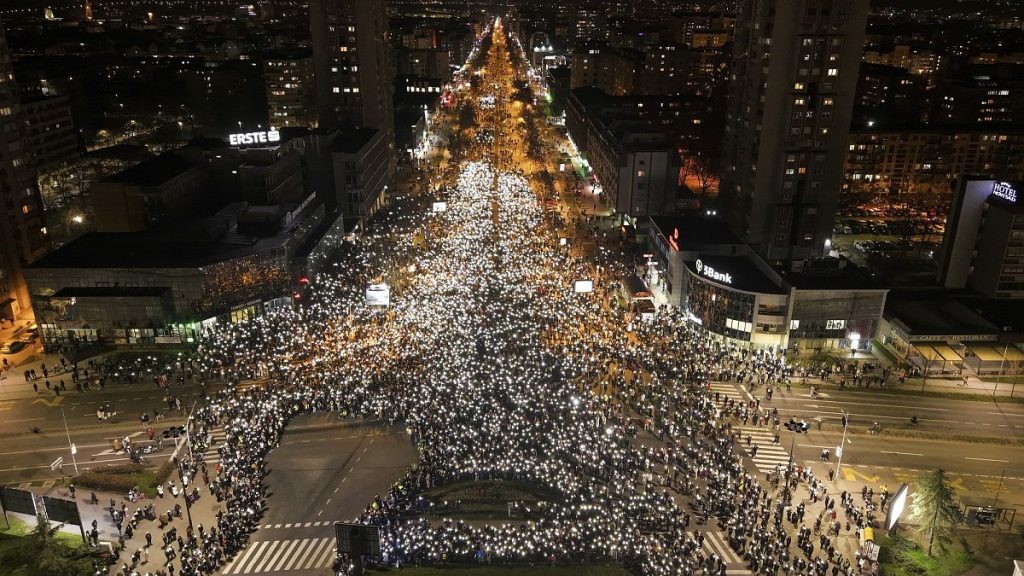The simmering discontent in Serbia has erupted into a full-blown student-led protest movement, the largest in decades, directly challenging President Aleksandar Vučić’s authority. Sparked by the tragic collapse of a concrete canopy at the Novi Sad railway station, which claimed 15 lives, the protests have evolved from an expression of grief and outrage into a broader indictment of systemic corruption that students believe permeates the government and jeopardizes public safety. The two-day march by hundreds of students from Belgrade to Novi Sad, covering a grueling 80 kilometers, symbolizes their unwavering commitment to demanding accountability and meaningful change. The planned blockade of three Danube River bridges in Novi Sad marks a significant escalation of their actions, aiming to disrupt daily life and force the government to address their concerns.
The student protests have already achieved a significant victory with the resignation of Prime Minister Miloš Vučević, a close ally of President Vučić. This concession, however, is perceived by the students as insufficient, a mere gesture rather than a genuine commitment to addressing the root causes of the tragedy and the broader issues of corruption and democratic backsliding. Their demands extend beyond a simple change in leadership, encompassing a thorough investigation into the circumstances surrounding the canopy collapse, the implementation of stricter safety regulations in infrastructure projects, and a broader push for greater transparency and accountability within the government. The students view the incident as a symptom of a deeper malaise, a systemic failure of governance that prioritizes political expediency and economic gain over public safety and the rule of law.
The Novi Sad train station canopy collapse has become a potent symbol of the perceived failures of the Vučić administration. The station, renovated twice in recent years as part of a deal with Chinese state companies, is seen as emblematic of the government’s opaque dealings with foreign entities and the potential for corruption in large-scale infrastructure projects. Critics argue that a culture of impunity and disregard for safety regulations, fostered by the government’s increasingly authoritarian tendencies, created the conditions for this tragedy. The students’ persistent protests underscore their refusal to accept superficial solutions or political scapegoating. They demand a fundamental shift in governance, one that prioritizes transparency, accountability, and the well-being of its citizens.
The government’s response to the protests has been a mix of concessions and defiance. While the resignation of the Prime Minister suggests a willingness to appease the protesters, the release from detention of former construction minister Goran Vesić, one of the 13 individuals charged in connection with the canopy collapse, casts doubt on the government’s commitment to a truly independent investigation. This perceived lack of transparency further fuels the protesters’ distrust and strengthens their resolve to continue their demonstrations. The ongoing protests reveal a deep chasm between the government and a significant portion of the population, particularly the younger generation, who are increasingly vocal in their demands for democratic reforms and a more accountable government.
President Vučić and his Serbian Progressive Party (SNS) have faced mounting criticism for their increasingly authoritarian grip on power and the erosion of democratic freedoms. While promising to lead Serbia into the European Union, Vučić’s actions have often contradicted this aspiration, raising concerns about his commitment to democratic values and the rule of law. The student-led protests represent a significant challenge to his authority, highlighting the growing dissatisfaction with his leadership style and the perceived prioritization of political consolidation over the needs and concerns of the Serbian people. The students’ unwavering determination in the face of potential repercussions demonstrates the depth of their commitment to holding the government accountable and demanding real change.
The student protests in Serbia, sparked by the tragic incident at the Novi Sad railway station, have exposed deep-seated societal frustrations with corruption, lack of transparency, and the erosion of democratic principles. The students’ courageous actions, including the arduous march from Belgrade to Novi Sad and the planned bridge blockades, represent a significant challenge to President Vučić’s authority and a powerful call for a more just and democratic Serbia. The outcome of these protests remains uncertain, but their impact on the political landscape of Serbia is undeniable, signaling a potential turning point in the country’s trajectory and a growing demand for accountability and meaningful change.

